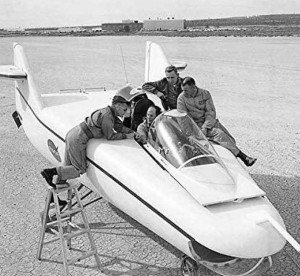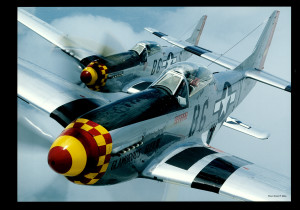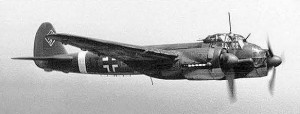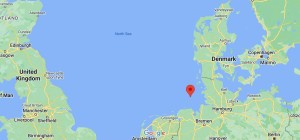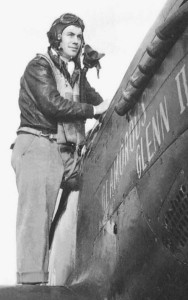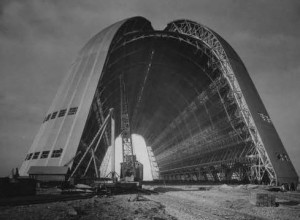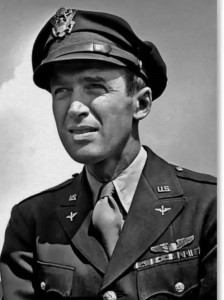In his own words from Yeager, An Autobiography pp 290-297:
“The Air Force had only been integrated seven or eight years by the time I became a fighter pilot. I came up through the ranks as an enlisted man, the same as Chuck Yeager, but it wasn’t easy for me as a black man. There were racial incidents along the way with no shortage of rednecks eager to shoot me down. Only a handful of black pilots were scattered around the world in those days, and I knew I couldn’t afford to make any serious mistakes, but I was young, full of piss and vinegar, and when Chuck Yeager became my squadron commander in Germany, he stood between me and guys ready to jump me. Chuck just wouldn’t tolerate that kind of crap. It is true he grew up in West Virginia where there are some definite racial attitudes, but there is also a camaraderie among those who know what it’s like to be down and out. Without a doubt, he saved my neck on several occasions. Serving with him became a highlight of my life. ”
Our squadron of Sabre jets was part of a three squadron lighter-bomber wing stationed at Hahn which in 1955 was a brand-new fighter base up on the “Houndsback” two thousand feet above the Mosel River, about thirty miles from Wiesbaden. Europe has the worst flying weather in the world, and Hahn had the worst weather in all of Europe. Heavy fog and rain were continuous and only God knew why the Air Force decided to build a base up there. We lost a few pilots in the fog, while learning to be extremely proficient bac-weather pilots.
We couldn’t believe that the famous Chuck Yeager was heading our way. We knew of course, that he had broken the sound barrier and was a great test pilot. In fact, just before he came to us, he had been back in Washington to receive the Harmon Trophy at the White House for his flight in the X-1A. But fighter pilots aren’t impressed by anything but dogfighting , which was about all we did. Anytime we took off, we knew guys were sitting upstairs waiting to jump our ass. So, there was a helluva line of eager young pilots anxious to jump our new squadron commander and see what he was made of. Testing Yeager turned out to be a massacre. He waxed everybody, and with such ease that it was shameful. The word got around that he was somebody very special.
In those days we flew the F model of the Sabre, which was slow. The Canadian fighter jocks in Europe loved to dogfight us in their own lighter, more maneuverable Mark V Sabres. They were merciless and there wasn’t much we could do about it. But Yeager took those guys on every chance he got. He flew the F like the rest of us, but he waxed those Canadians every time. We flew at maybe 90 percent of capability. Yeager flew at 101 percent. It was incredible to fly behind him in a traffic pattern because he flew with such precision. And he trained us by having us take turns flying his wing., which is really like flying his airplane because we emulated all his turns and maneuvers to keep up. For example, if he went into a tight diving turn, we went right with him even though we may not have done that before. I flew his wing when a couple of Canadian jocks bounced us. Chuck radioed to me, “Hold on,” and did a tight pull up, simultaneously hitting his speed brakes. The Canadians zipped past us and we ended up waxing their tails. I was impressed.
Another time I flew his wing and socked in as tight as I could, thinking that was what a good wingman should do. Chuck told me to move my control stick from side to side. I saw that my airplane barely reacted. At the speed we were moving, the controls were very sluggish, and if anything happened I wouldn’t have the quickness to avoid colliding with him. That’s how he delivered the message that I was flying too close.
Flying with him we flew at our maximum ability because that’s how he flew. We would get up in the clouds and instead of flying around them, we’d maneuver in and out. You really do some complicated flying when you start playing with clouds. They have holes and unusual shapes that create tricky maneuvers – good training for aerial combat. Instead of taking a straight thirty-minute flight somewhere, we’d go down on the deck below 1000 feet. We could get there either way, a relaxed cruise or skimming over trees and barns. The hard way we learned something; Yeager wouldn’t let us get there the easy way.
We used to make bets on how close to the end of the runway his wheels would touch down on landing. actually go out with a measuring tape. He was always a foot or two right at the end of the runway, a perfect landing every time, even in near zero visibility.
My nickname in the squadron was “Jock” because I had played college basketball. We were flying air-to-ground gunnery in France, and after I made my pass at the target, Chuck radioed, “Well, Jock, how did you do?” I told him I thought I scored about forty percent. He said, “I beat you.” I said, “I’ll bet you on that.” So, when we landed I called the range officer to get our scores. I got forty percent. That SOB got eighty percent. I put down the phone and crawled off the base. Later, he told me, “God Jock, that was really great. I could actually see the bullets hitting the target.” I said “What!” He replied “The vortex from the shells, I saw them.”
We were coming back from gunnery in North Africa when he came on the radio” “Hey, you guys look at that tanker burning down there.” We said, “What are you talking about?” We flew for another ten minutes and looked down. Sure enough, there was a ship on fire. We couldn’t imagine how he could see so much better than the rest of us and wondered if he had binoculars stashed away in his cockpit.
Chuck came to us as a captain and rather quickly was promoted to Lieutenant Colonel. We were a good squadron and he fit right in. He operated with a twinkle in his eye, as easygoing and friendly as any squadron leader we had ever encountered: his rank was there because he wore it on his collar, but he lived to fly like the rest of us and probably flew more than the other squadron commanders in the wing. He was right in the middle of our beer busts, parties, and poker games. Being a squadron commander was all any young fighter pilots ever hoped to become in this world and we just hero worshipped the guy. We busted our assed to please him and earn his respect. If he sent for one of us and asked a lot of questions, we knew damn well we had done something wrong and were in trouble. He would listen to an explanation and say: “You’re full of shit!” And, God, to get that from him was worse than a slap in the face and having your epaulets ripped off. I don’t recall him ever chewing anyone out. He didn’t have to. Everyone, including all the enlisted men in the ground crews, took real pride being in Yeager’s squadron.
We were living with a legend and we knew it even then. We read everything we could find about him and learned he was a World War II combat ace. We’d sit with him in the officers’ club prime him with beers and get him to talk about airplanes and flying, soaking up every damned word. Try as we might, we couldn’t get him to talk about his exploits but there was nothing about aviation that he didn’t know. Whatever he really thought about our individual flying skills he kept to himself. Nobody ever heard him say, “I don’t think you can hack this.” His attitude was, “Here’s what we’re gonna do, and you’ll do it just fine.” He made us think we could all fly with his capabilities , which was absolutely crazy. For example, he made his personal mark in the squadron by ordering us to wear red scarves and deciding that we would fly in a diamond formation. Air Force regulations demanded that all squadrons fly in a stacked formation, but Chuck just shrugged. He said, “The acrobatic teams fly a diamond and we’re as good as they are.” We Became “The Red Diamonds.”
One day an Air Force inspector was checking out the armament switches on one of our airplanes when suddenly all six fifty-caliber machine guns began firing over the woods toward a German village. Fortunately, no civilians were hurt, but there were investigations, and the result was that special safety pins were inserted in the trigger mechanisms that kept them from firing. Each pin had a big red tag attached to it, and we could barely fly with all the crap on our control sticks. We bitched and moaned about it, then, lo and behold, those pins began disappearing. We’d climb in the cockpit and report them missing. Colonel Yeager finally called us together and said, “Hey, you guys, leave those pins alone. Regulations are regulations.” But they kept disappearing until not one airplane in the squadron had a safety pin left. In fact, we almost forgot they ever existed.
One day, months later, Chuck asked someone to fetch something from his locker. There were all those missing pins, stockpiled in our squadron commander’s locker. He was the one who removed them all. Chuck was a free-wheeler, and the Air Force bureaucracy drove him nuts. He knew we had to live within the system and could not fight it head on and win. But damn, he knew how to resist.
Col Fred Ascani commanded the entire wing. He was tough and strict, a real terror to work for. Ascani had been General Boyd’s deputy so Chuck knew him well. Even so, Ascani had bugaboos, and if anyone violated his rules, he lowered the boom. His biggest bugaboo was accidents. When he took over the wing, the accident rate was atrocious, so he staked his career on a zero-accident rate. Wreck and airplane and he’d wreck you. We flew into Pisa, Italy, one day and a guy in squadron snapped the nose wheel off his Sabre while landing. Chuck called the squadron maintenance officer and gave him a list of parts that would be needed to bolt a fixed nose gear on the airplane, and they arrived on a C-47, while Chuck pounded out the air intake with a sledgehammer. The repairs took nearly a day. Then Chuck flew that airplane back to Germany with the nose wheel down and bolted, a really tricky piece of flying. It was rolled into the back of a dark hangar, quickly repaired and never reported.
But then I crashed.
I was flying alone, coming down to refuel outside of Paris on a beautiful Sunday morning. I was feeling real good and began doing rolls coming down. But my control stick stuck and I couldn’t stop rolling. I got down to 1,400 feet , more afraid of Colonel Ascani than of dying. Finally, I ejected. I was so low that I did only two swings in my chute before I landed in a tree.
Ascani went out of his mind. He roared in on Chuck: “What in hell was Hatch doing? Why was he rolling that airplane?”
Chuck said, “Hell, Colonel, he was doing exactly what he was supposed to be doing. He was doing a clearing roll.”
“A what?”
Chuck said, “That’s right. Anytime we are descending, we do a roll to make sure we aren’t letting down on top of another airplane. It’s a safety precaution. All my people do it.”
Chuck saved my precious ass. I had no business doing those rolls, and I could’ve been court-martialed, my career ruined. Ascani just said, “Yeah, well, I suppose…” That was the end of it.
There’s nothing better on this earth than to be part of a fighter squadron. You really are close and sharing. By the time my three-year tour came to an end. I was one of the old heads, an element leader, one of the guys Chuck counted on. I extended my tour for another year. Four of us senior guys did that. Chuck was gone a lot of the time, and he needed us. He was the Air Force’s showpiece in Europe, and they were always sending him off somewhere on special assignment. Ascani was not pleased, but there was nothing he could do about it. The British or French would request him through the State Department, asking that he be allowed to help evaluate on of their new aircraft. The guy was a real celebrity and he was constantly traveling all over Europe to air shows and conferences. Wherever he went he was always bumping into somebody he knew – pilots, sportsmen, princes, name it. He would meet a person only once and remember him twenty years later – everything about him, too.; I’ve seen him do it. He’d be requested to hunt pheasants in Portugal with some dignitary. General Le May, the head of SAC, flew into Spain and sent for Chuck to show him off to the Spanish air force brass. Then the two of them went partridge hunting with Franco. I never saw Chuck hunt, but he once went out with General Gross, vice commander of the Twelfth Air Force, hunting German roebuck deer, which are no bigger than dogs. Gross took one or two shots and missed, but Chuck bagged that deer at six hundred yards. The general couldn’t believe it. He said, “God almighty, Chuck how in hell…”
The guy was unbelievable. Because of him our wing won all the USAF European gunnery meets. Ascani loved him for that. He has high man in air-to-air and air-to-ground every time. The other contestants shook in their boots having to confront Yeager. One gunnery mission he flew, they were firing two guns and one of his guns jammed. So, using one gun he scored 85 percent – some unheard-of thing like that – and he won anyway. The Air Force maintained a huge gunnery facility at Wheelus in Tripoli and we went down there for a month at a time, living in tents out on the desert, flying and shooting night and day. One time he flew in a day after we arrived and I sat upstairs waiting for him. As soon as I saw his Sabre, I bounced him. I came in right on his tail and then took off with full power before he could react. I said, “Welcome to Tripoli, Colonel Yeager.” He laughed. “Goddam, Jock, if I catch you, I’ll whip the black off of you.” Those would be fighting words from anyone else. From him, I just said, “Well, Colonel, you’ll have to catch me first.’”
c. GCYI
